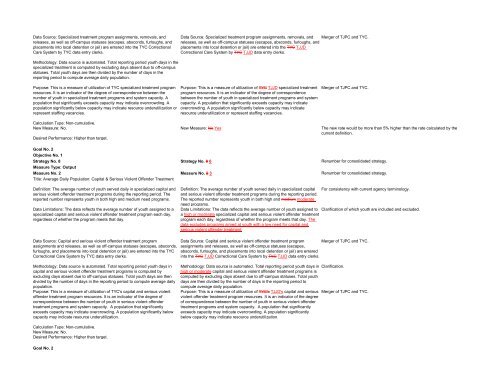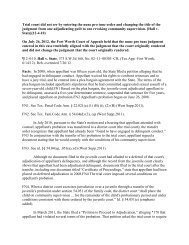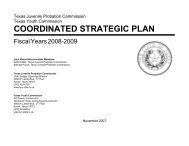Data Limitations: The <strong>Texas</strong> Youth Commission accepts all youth committed by<strong>Texas</strong> courts. Societal, law enforcement, and juvenile justice factors beyond theagency’s control may affect the timing and number <strong>of</strong> youth committed to TYC,consequent efficiencies <strong>of</strong> scale, and general rehabilitation treatment costs peryouth per day. This measure only includes the costs expended in the strategy.Expenditures may increase because <strong>of</strong> additional appropriations.Data Source: Program assignments and releases as well as <strong>of</strong>f-campusstatuses (escapes, absconds, furloughs, and placements into local detention orjail) are entered into the TYC Correctional Care System by TYC data entryclerks. The average daily population <strong>of</strong> youth in general rehabilitation treatmentis summarized from this automated data system. Expenditures for generalrehabilitation treatment are classified and entered in the TYC financialaccounting system. Cost data for the reporting period is retrieved from thissystem.Data Limitations: The <strong>Texas</strong> Youth Commission accepts all youth committedby <strong>Texas</strong> courts. Societal, law enforcement, and juvenile justice factorsbeyond the agency’s control may affect the timing and number <strong>of</strong> youthcommitted to TYC, consequent efficiencies <strong>of</strong> scale, and generalrehabilitation treatment costs per youth per day. This measure only includesthe costs expended in the strategy. Expenditures may increase because <strong>of</strong>additional appropriations.Data Source: Program assignments and releases as well as <strong>of</strong>f-campusstatuses (escapes, absconds, furloughs, and placements into local detentionor jail) are entered into the TYC <strong>TJJD</strong> Correctional Care System by TYC<strong>TJJD</strong> data entry clerks. The average daily population <strong>of</strong> youth in generalrehabilitation treatment is summarized from this automated data system.Expenditures for general rehabilitation treatment are classified and enteredin the TYC <strong>TJJD</strong> financial accounting system. Cost data for the reportingperiod is retrieved from this system.The sentences requested to be deleted affect the agency rate by narrowingor broadening the types <strong>of</strong> youth committed, but does not affect the quality <strong>of</strong>the data.Merger <strong>of</strong> TJPC and TYC.Methodology: Total dollars expended on an accrual basis consistent with Methodology: Total dollars expended on an accrual basis consistent with Revise for consolidated strategy.<strong>General</strong>ly Accepted Accounting Principles (GAAP) from all appropriations for the <strong>General</strong>ly Accepted Accounting Principles (GAAP) from all appropriations for<strong>General</strong> Rehabilitation Treatment Strategy during the reporting period aredivided by the Average Daily Population in <strong>General</strong> Rehabilitation Programs,and then divided by the number <strong>of</strong> days in the reporting period.the <strong>General</strong> Rehabilitation Integrated Treatment Strategy during thereporting period are divided by the Average Daily Population: in <strong>General</strong>Rehabilitation Programs Integrated Treatment, and then divided by thenumber <strong>of</strong> days in the reporting period.Purpose: This measure provides the average per-day cost <strong>of</strong> providing generalrehabilitation treatment for TYC-committed youth.Purpose: This measure provides the average per-day cost <strong>of</strong> providinggeneral integrated rehabilitation treatment for TYC <strong>TJJD</strong>-committed youth.Merger <strong>of</strong> TJPC and TYC.Calculation Type: Non-cumulative.Calculation Type: Non-cumulative.New Measure: No. New Measure: No Yes. Measure includes expanded population and services.Desired Performance: Lower than target.Goal No. 2 Goal No. 2 Modify: substantive change. Consolidate B.1.6, B.1.7, B.1.8 into a singlestrategy. Staff and resources cross strategies making it difficult and not usefulto separate the strategies.Objective No. 1 Objective No. 1Strategy No. 8: Specialized Rehabilitation TreatmentStrategy No. 8: Specialized Rehabilitation TreatmentDescription: Specialized Rehabilitation TreatmentDescription: Specialized Rehabilitation TreatmentGoal No. 2Objective No. 1Strategy No. 8 Strategy No. 8 6 Renumber for consolidated strategy.Measure Type: OutputMeasure No. 1 Measure No. 1 2 Renumber for consolidated strategy.Title: Average Daily Population: Specialized TreatmentDefinition: The average number <strong>of</strong> youth served daily in specialized treatmentprograms for youth with specialized needs to include capital or other seriousviolent <strong>of</strong>fense history, sex <strong>of</strong>fense history, alcohol or other drug abuse ordependence history, or mental health problems. The reported numberrepresents youth in both high and medium need programs. The majority <strong>of</strong> theseservices are provided by staff who are either licensed or certified, or are workingunder the supervision <strong>of</strong> licensed or certified providers.Definition: The average number <strong>of</strong> youth served services provided daily inspecialized treatment programs for youth with specialized needs to includecapital or other serious violent <strong>of</strong>fense history, sex <strong>of</strong>fense history, alcohol orother drug abuse or dependence history, or mental health problems. Thereported number represents youth in both high and medium moderate needprograms, and youth regularly receiving psychiatric services. The majority <strong>of</strong>these services are provided by staff who are either licensed or certified, orare working under the supervision <strong>of</strong> licensed or certified providers.Modify: Substantive change. Youth receiving psychiatric services will becounted as receiving mental health services. Youth may be counted morethan once if receiving more than one specialized treatment service type.Moderate need is for consistency with current agency terminology. Youthreceiving regularly psychiatric servcies have not been included in the past,because psychiatrists were paid from a different strategy.Data Limitations: The data reflects the average number <strong>of</strong> youth assigned tospecialized treatment programs each day, regardless <strong>of</strong> whether the programmeets that day. Many youth have concurrent needs for other specializedtreatment programs. Youth who receive multiple treatments simultaneously willbe represented only once per day, thus the actual number <strong>of</strong> services providedwill tend to be greater than the number reported.Data Limitations: The data reflects the average number <strong>of</strong> youth assigned to Modify: Substantive change. Youth may be counted more than once ifspecialized treatment programs each day, regardless <strong>of</strong> whether the receiving more than one specialized treatment service type.program meets that day. Many youth have concurrent needs for othermultiple specialized treatment programs. Youth who receive multipletreatments simultaneously will be represented only once per day for each <strong>of</strong>the four services they are in, thus the actual number <strong>of</strong> services provided willtend to be greater than the number reported.
Data Source: Specialized treatment program assignments, removals, andreleases, as well as <strong>of</strong>f-campus statuses (escapes, absconds, furloughs, andplacements into local detention or jail) are entered into the TYC CorrectionalCare System by TYC data entry clerks.Data Source: Specialized treatment program assignments, removals, and Merger <strong>of</strong> TJPC and TYC.releases, as well as <strong>of</strong>f-campus statuses (escapes, absconds, furloughs, andplacements into local detention or jail) are entered into the TYC <strong>TJJD</strong>Correctional Care System by TYC <strong>TJJD</strong> data entry clerks.Methodology: Data source is automated. Total reporting period youth days in thespecialized treatment is computed by excluding days absent due to <strong>of</strong>f-campusstatuses. Total youth days are then divided by the number <strong>of</strong> days in thereporting period to compute average daily population.Purpose: This is a measure <strong>of</strong> utilization <strong>of</strong> TYC specialized treatment programresources. It is an indicator <strong>of</strong> the degree <strong>of</strong> correspondence between thenumber <strong>of</strong> youth in specialized treatment programs and system capacity. Apopulation that significantly exceeds capacity may indicate overcrowding. Apopulation significantly below capacity may indicate resource underutilization orrepresent staffing vacancies.Purpose: This is a measure <strong>of</strong> utilization <strong>of</strong> TYC <strong>TJJD</strong> specialized treatmentprogram resources. It is an indicator <strong>of</strong> the degree <strong>of</strong> correspondencebetween the number <strong>of</strong> youth in specialized treatment programs and systemcapacity. A population that significantly exceeds capacity may indicateovercrowding. A population significantly below capacity may indicateresource underutilization or represent staffing vacancies.Merger <strong>of</strong> TJPC and TYC.Calculation Type: Non-cumulative.New Measure: No. New Measure: No.Yes The new rate would be more than 5% higher than the rate calculated by thecurrent definition.Desired Performance: Higher than target.Goal No. 2Objective No. 1Strategy No. 8 Strategy No. 8 6 Renumber for consolidated strategy.Measure Type: OutputMeasure No. 2 Measure No. 2 3 Renumber for consolidated strategy.Title: Average Daily Population: Capital & Serious Violent Offender TreatmentDefinition: The average number <strong>of</strong> youth served daily in specialized capital andserious violent <strong>of</strong>fender treatment programs during the reporting period. Thereported number represents youth in both high and medium need programs.Data Limitations: The data reflects the average number <strong>of</strong> youth assigned to aspecialized capital and serious violent <strong>of</strong>fender treatment program each day,regardless <strong>of</strong> whether the program meets that day.Definition: The average number <strong>of</strong> youth served daily in specialized capital For consistency with current agency terminology.and serious violent <strong>of</strong>fender treatment programs during the reporting period.The reported number represents youth in both high and medium moderateneed programs.Data Limitations: The data reflects the average number <strong>of</strong> youth assigned to Clarification <strong>of</strong> which youth are included and excluded.a high or moderate specialized capital and serious violent <strong>of</strong>fender treatmentprogram each day, regardless <strong>of</strong> whether the program meets that day. Thedata excludes programs aimed at youth with a low need for capital andserious violent <strong>of</strong>fender treatment.Data Source: Capital and serious violent <strong>of</strong>fender treatment programassignments and releases, as well as <strong>of</strong>f-campus statuses (escapes, absconds,furloughs, and placements into local detention or jail) are entered into the TYCCorrectional Care System by TYC data entry clerks.Data Source: Capital and serious violent <strong>of</strong>fender treatment program Merger <strong>of</strong> TJPC and TYC.assignments and releases, as well as <strong>of</strong>f-campus statuses (escapes,absconds, furloughs, and placements into local detention or jail) are enteredinto the TYC <strong>TJJD</strong> Correctional Care System by TYC <strong>TJJD</strong> data entry clerks.Methodology: Data source is automated. Total reporting period youth days incapital and serious violent <strong>of</strong>fender treatment programs is computed byexcluding days absent due to <strong>of</strong>f-campus statuses. Total youth days are thendivided by the number <strong>of</strong> days in the reporting period to compute average dailypopulation.Purpose: This is a measure <strong>of</strong> utilization <strong>of</strong> TYC's capital and serious violent<strong>of</strong>fender treatment program resources. It is an indicator <strong>of</strong> the degree <strong>of</strong>correspondence between the number <strong>of</strong> youth in serious violent <strong>of</strong>fendertreatment programs and system capacity. A population that significantlyexceeds capacity may indicate overcrowding. A population significantly belowcapacity may indicate resource underutilization.Methodology: Data source is automated. Total reporting period youth days inhigh or moderate capital and serious violent <strong>of</strong>fender treatment programs iscomputed by excluding days absent due to <strong>of</strong>f-campus statuses. Total youthdays are then divided by the number <strong>of</strong> days in the reporting period tocompute average daily population.Purpose: This is a measure <strong>of</strong> utilization <strong>of</strong> TYC's <strong>TJJD</strong>'s capital and seriousviolent <strong>of</strong>fender treatment program resources. It is an indicator <strong>of</strong> the degree<strong>of</strong> correspondence between the number <strong>of</strong> youth in serious violent <strong>of</strong>fendertreatment programs and system capacity. A population that significantlyexceeds capacity may indicate overcrowding. A population significantlybelow capacity may indicate resource underutilization.Clarification.Merger <strong>of</strong> TJPC and TYC.Calculation Type: Non-cumulative.New Measure: No.Desired Performance: Higher than target.Goal No. 2
















